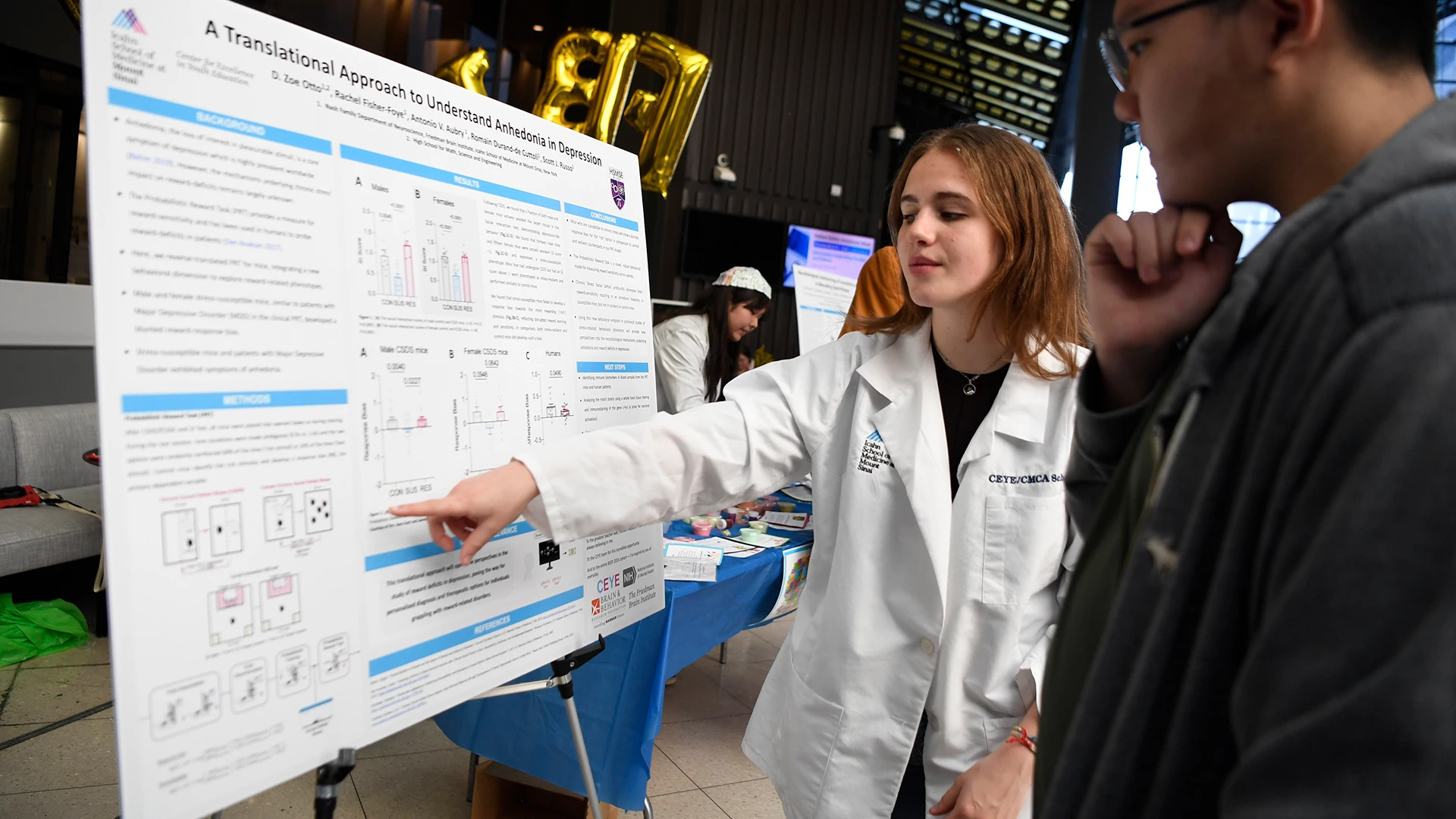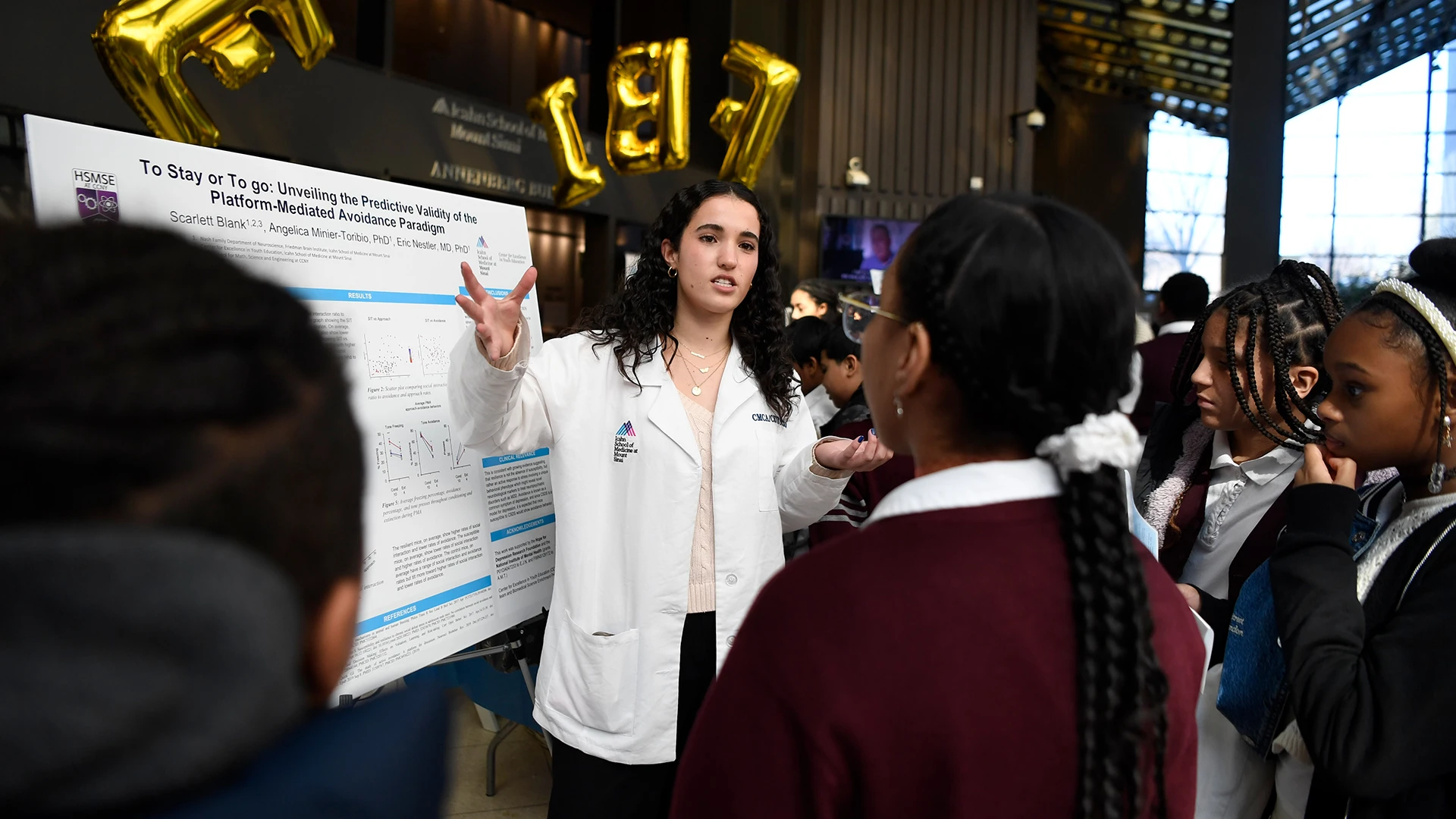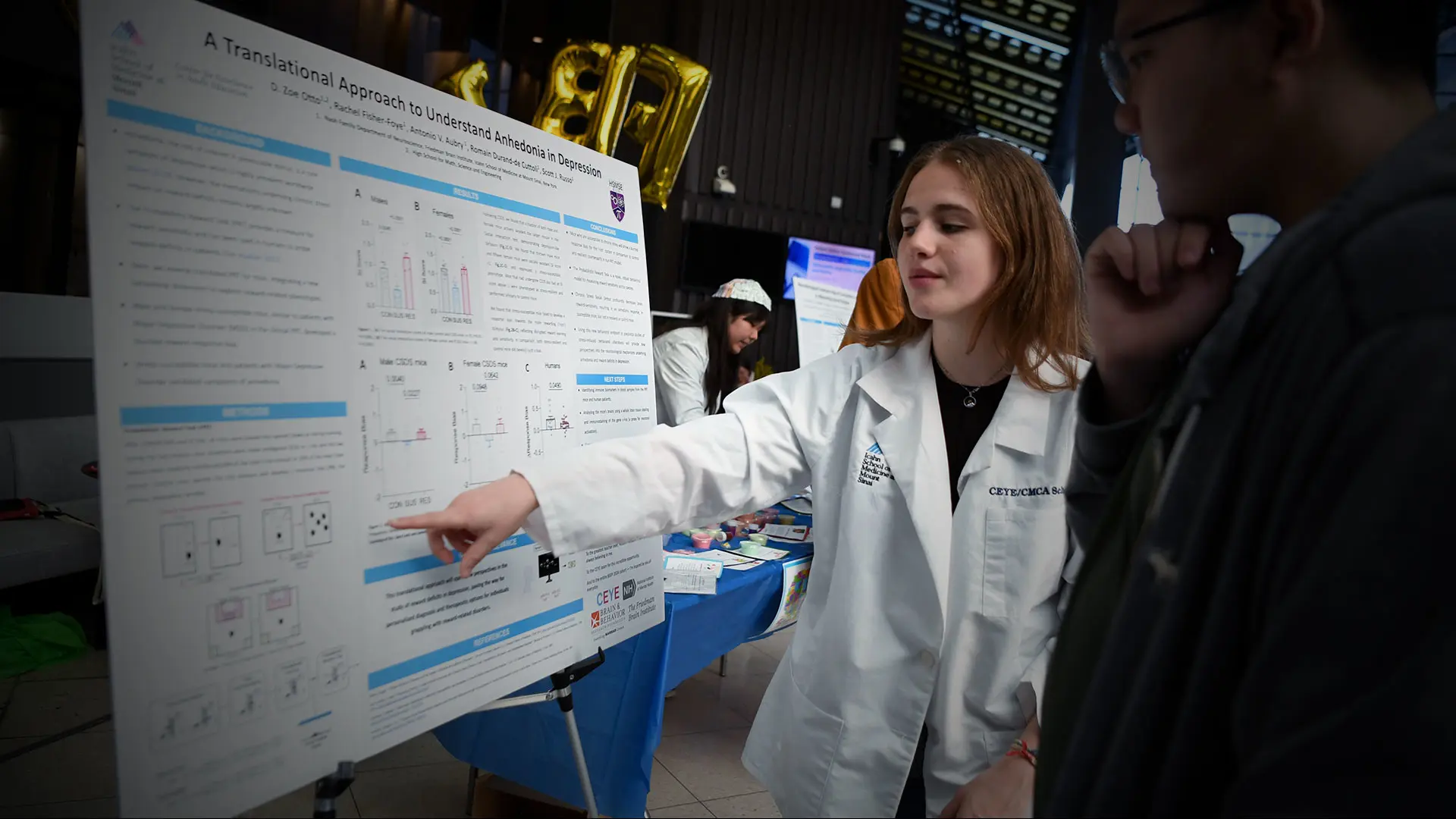The program is among several robust school-year and summer pathway programs offered by CEYE.
“In the first year of the program, students learn the basics of cellular and molecular biology, genetics and genomics, and basic neuroscience and neurobiology to prepare them for joining research laboratories,” says Hossein Aleyasin, MD, PhD, CEYE instructor, Adjunct Assistant Professor in the Nash Family Department of Neuroscience, and faculty at the High School for Math, Science and Engineering.
“This is a unique opportunity for students with a general interest in science but without prior lab experience to dive into real research early in their academic journey and stimulate their interest in discovery,” says Dr. Aleyasin. “By working alongside undergraduate and graduate students, postdoctoral fellows, and principal investigators, they gain valuable hands-on experience on a daily basis. They learn how to present their findings, receive feedback, and, most importantly, find role models among the scientists they work with. The program has had a significant impact, with most of the participating students choosing to major in life sciences or neuroscience.”
High school junior Zoe Otto is among those enrolled in the program. She is being mentored in the lab of Scott Russo, PhD, by postdoctoral fellow Romain Durand-de Cuttoli, PhD.

High school junior Zoe Otto at The Friedman Brain Institute Brain Fair explaining a lab research project to Oliver, also a junior.
She gave a presentation on “A Translational Approach to Understanding Anhedonia in Depression.” When Oliver, a high school junior attending the Brain Fair, stopped by to learn about the project, he said he was interested in knowing about “the logistics behind how you get the data and what the data mean, and how it can relate to other species.” He asked provocative questions as she explained the research.
Said Ms. Otto about her experience in the program: “I’ve been working in the Russo lab since the summer. I think it completely changed my life, quite honestly. I loved it. Working in the lab with people who really inspire and encourage me has made me very passionate about science—and especially, communicating about science.”
In the following Q&A, learn how working in top Mount Sinai neuroscience labs is transforming the lives of three students.
Scarlett Blank, Modeling Risk-Avoidance Behavior and the Impact of Social Stress
Lab: Eric J. Nestler, MD, PhD; Mentor: Angelica Minier-Toribio, PhD
This research allows scientists to gain a better understanding of risk assessment in different conditions, such as depression and other mental disorders.

High school junior Scarlett Blank explains her research to curious students.
Q. Briefly summarize your research project.
Scarlett: The platform-mediated avoidance (PMA) paradigm serves as a preclinical model to investigate approach-avoidance decision-making conflicts, shedding light on stress-sensitive cognitive processes. This study seeks to explore the face and predictive validity of the PMA paradigm. Face validity will be assessed by testing mice susceptible to a depression model, while predictive validity will be examined using benzodiazepines and selective serotonin reuptake inhibitors. Clorazepate and paroxetine, known for their anxiolytic and antidepressant properties, respectively, will be used to evaluate their effects within the PMA paradigm. This research aims to unveil insights into the translational validity of the PMA model, providing a deeper understanding of stress-sensitive decision-making processes and potential therapeutic interventions for conditions such as depression.
Q. How did you get interested in science?
Scarlett: Since I was in elementary school, I’ve loved the creativity and opportunity for discovery that science provided. I loved coming up with experiments, trying them at home, and getting a closer look at how the things we see every day work. During high school, I became interested in biology because I found it so fascinating that such small shifts in the body’s systems can have a huge effect on a person. In the past year in my lab, I’ve loved digging into the connection between biological systems and the way we think and act through neuroscience.
Q. What have you learned about science or your abilities through this experience?
Scarlett: The value of being part of a team. No project is done alone and the lab members depend on each other. The work that I do has a direct effect on others, and that collaborative mindset is so important. I’ve also learned how even the seemingly smallest tasks have a vital role in the bigger picture. If even one behavior test is done incorrectly, it can have a dramatic effect on the larger experiment. Finally I’ve learned to push myself intellectually. Coming into the lab, I had next to no knowledge on neuroscience. I’ve learned to ask lots of questions, research the topics I’m learning about, and take a hands-on approach to learning about the brain. Everyone in the lab is excited to share their passion for neuroscience with me, and I’m so impressed by how much I’ve learned over the past year.
Vanesa Cevallos and Heidy Gonzales, Down Syndrome Mouse Model and Characterization
Lab: Ki Ann Goosens, PhD; Mentor: JoColl Burgess, PhD
This research effort provides valuable insights for improving the lives of those with Down syndrome.

Hossein Aleyasin, MD, PhD, at a student poster presentation with Heidy Gonzales, left, and Vanesa Cevallos.
Q. Briefly summarize your research project.
Vanesa and Heidy: Down syndrome (DS) therapies aiming to help improve the motor skills of DS patients have focused primarily on the central nervous system, seeing if neurodevelopmental-based therapy would help improve the encompassing sensory and neurodevelopmental aspects of the condition. We are taking a different approach by exploring if there is a correlation between elevated follicle-stimulating hormone (FSH) levels with issues such as higher fat levels, lower cognitive function, and lower bone mineral density (BMD). Patients with DS have shown that elevated levels of FSH are linked with a higher prevalence of displaying obesity, osteoporosis, and early-onset Alzheimer’s disease. We investigated this relationship in DS mouse models Ts65Dn and TcMAC. Our results suggested a correlation between elevated levels of FSH with less lean mass, cognitive function, and BMD.
Q. How did you get interested in science?
Vanesa: My cousin, who is a surgeon, was the one who first introduced me to science. He told me of a time when a patient was in critical condition that required immediate treatment. He had to act fast and perform surgery that required a tremendous amount of precision and care. Hearing about the difficulties he faced inspired me to pursue a career in science so that I can assist others with their health. This inspiration grew even stronger when my mother fell ill. I felt helpless and grew more determined to gain more knowledge so that I could help others in their time of need and reassure their families that they were in good hands.
My interest in science expanded after my high school science classes became more hands-on with labs and activities. Discussing our findings and observations was one of my favorite parts. I developed a strong desire to learn more about science and to be challenged in a variety of ways.
Heidy: I have always been a very curious and resilient person, always intrigued by how organisms function. Watching my cousin go through anaphylactic shock was one of the turning points for me, which made me take research more seriously as I became fascinated with the immune system. I found it amazing that the body could react so intensely over something harmless and negatively impact itself in the process. Throughout the day I question things I see: How is it that dogs look so different yet are the same species? Why can fish breathe underwater while I can't? Questions like these are what motivated me to do research on what interested me. Unlike any other subject, I could spend hours researching without feeling tired.
Q. What have you learned about science or your abilities through this experience?
Vanesa: CEYE has allowed me to go through many different experiences. I’ve always thought of research as something I’d never get to do unless I had a PhD, so when the opportunity to conduct research presented itself, I was ecstatic. Undertaking research has helped me realize how vital it is. Being able to learn new things while doing research is something I enjoy. We work together to discuss results and generate ideas, which showed that research is done by a team rather than only one person. This experience opened me up to a new part of science that I truly enjoy. I definitely want a career that is hands-on.
Heidy: In CEYE, which is the program that gave me a placement in a lab, I have learned more about topics like biology, biomedical research, and biotechnology. While I have expanded my knowledge in the science department, what I feel I have had the most growth in is my character and my habits.
Being placed in a lab has made me more open toward others as it benefits me to be more friendly and interactive with my mentor and PI. Having a research project to work on has made me more organized and mission oriented, as I know I can't slack off if I want to help my mentor gather more data. The habits I gained from this experience will continue as I move into the next step of my life. Having the ability to also know how to perform qMRI, DEXA, ELISA, PCR, and fear conditioning also helps me prepare for labs in college. I will already be one step ahead.
